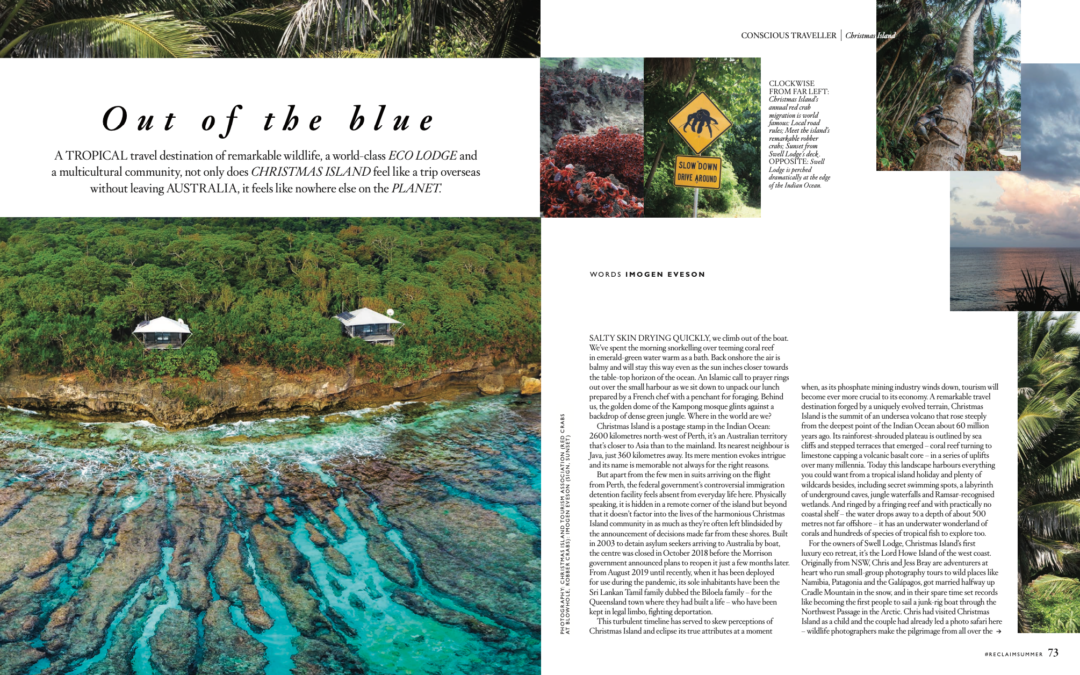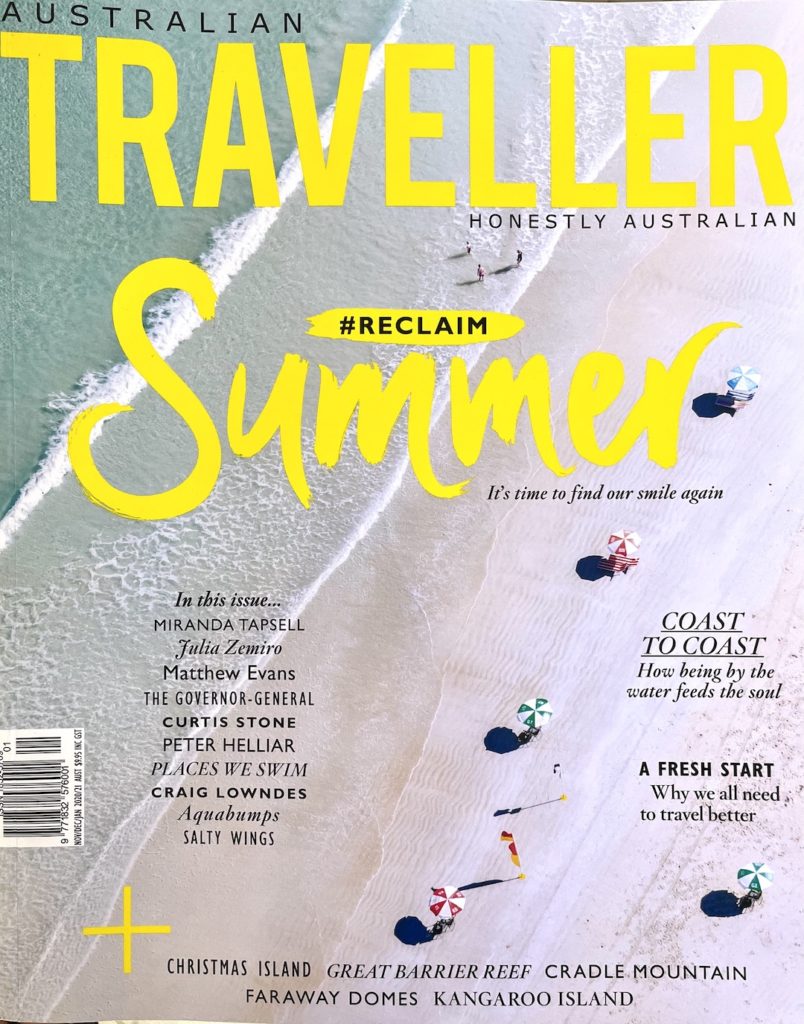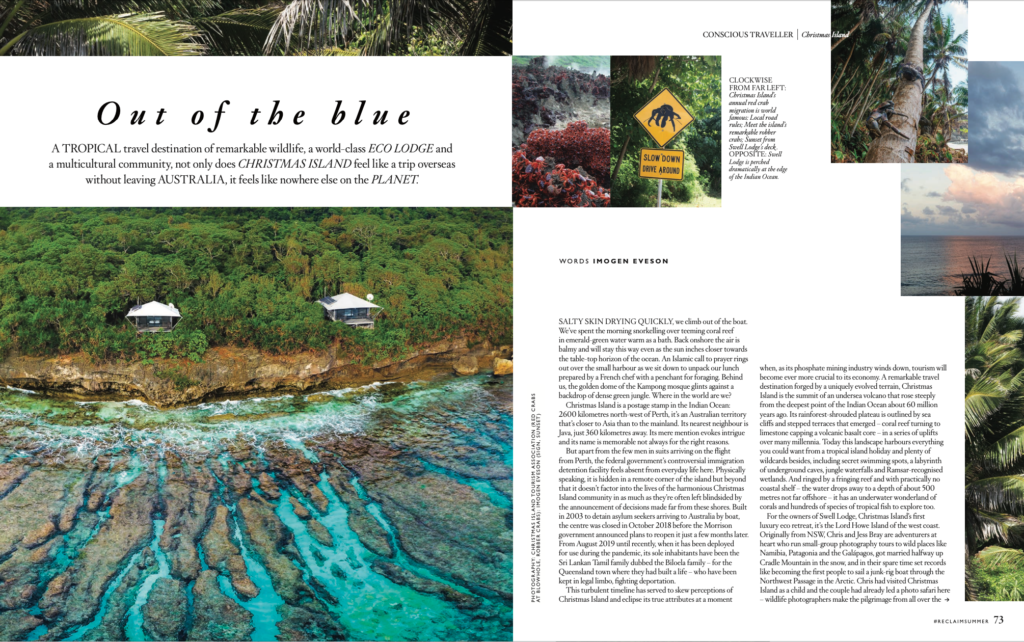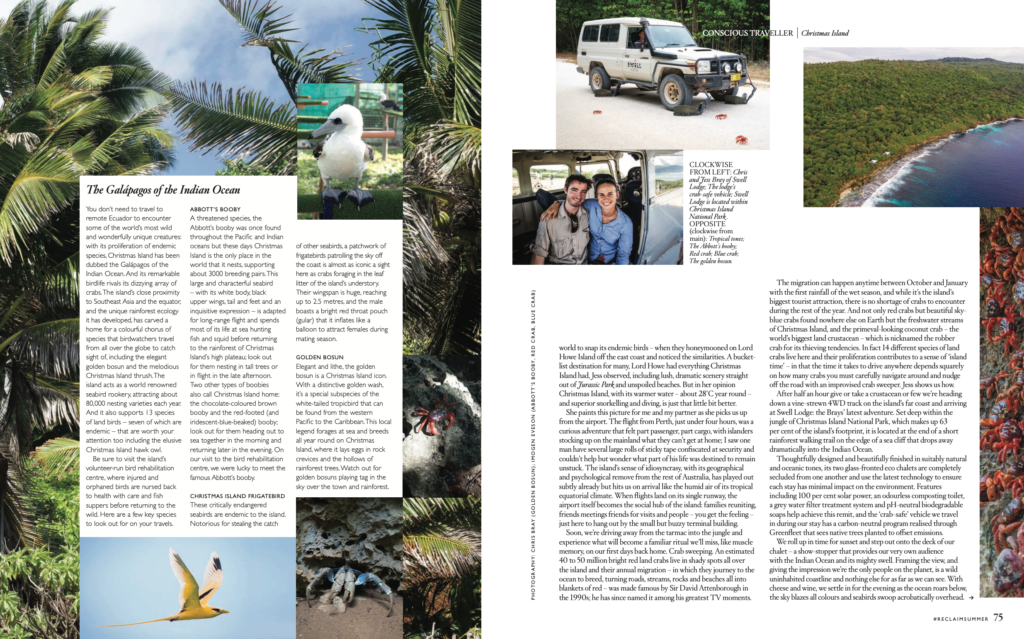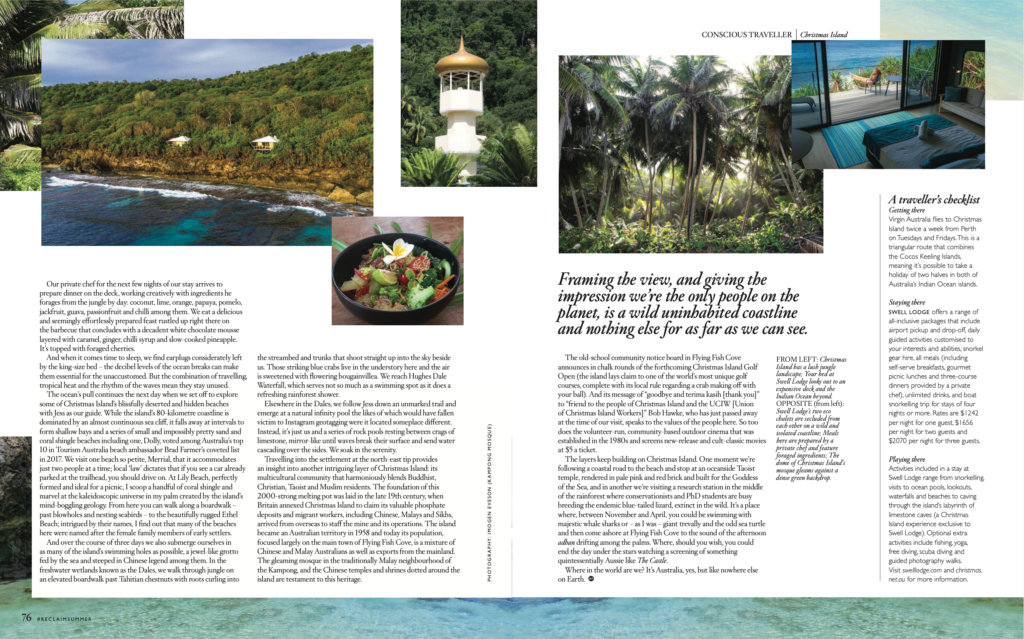Imogen Eveson describes her incredible holiday experience on Christmas Island in Australian Traveller magazine as; “A tropical travel destination of remarkable wildlife, a world-class Eco Lodge and a multicultural community. ” She says, “…not only does Christmas Island feel like a trip overseas without leaving Australia, it feels like nowhere else on the planet.”
Out of the Blue
Salty skin drying quickly, we climb out of the boat. We’ve spent the morning snorkelling over teeming coral reef in emerald-green water warm as a bath. Back onshore the air is balmy and will stay this way even as the sun inches closer towards the table-top horizon of the ocean. An Islamic call to prayer rings out over the small harbour as we sit down to unpack our lunch prepared by a French chef with a penchant for foraging. Behind us, the golden dome of the Kampong mosque glints against a backdrop of dense green jungle. Where in the world are we?
Christmas Island’s Place in the World
Christmas Island is a postage stamp in the Indian Ocean: 2600 kilometres north-west of Perth, it’s an Australian territory that’s closer to Asia than to the mainland. Its nearest neighbour is Java, just 360 kilometres away. Its mere mention evokes intrigue and its name is memorable not always for the right reasons.
But apart from the few men in suits arriving on the flight from Perth, the federal government’s controversial immigration detention facility feels absent from everyday life here. Physically speaking, it is hidden in a remote corner of the island but beyond that it doesn’t factor into the lives of the harmonious Christmas Island community in as much as they’re often left blindsided by the announcement of decisions made far from these shores. Built in 2003 to detain asylum seekers arriving to Australia by boat, the centre was closed in October 2018 before the Morrison government announced plans to reopen it just a few months later. From August 2019 until recently, when it has been deployed for use during the pandemic, its sole inhabitants have been the Sri Lankan Tamil family dubbed the Biloela family – for the Queensland town where they had built a life – who have been kept in legal limbo, fighting deportation.
This turbulent timeline has served to skew perceptions of Christmas Island and eclipse its true attributes at a moment when, as its phosphate mining industry winds down, tourism will become ever more crucial to its economy. A remarkable travel destination forged by a uniquely evolved terrain, Christmas Island is the summit of an undersea volcano that rose steeply from the deepest point of the Indian Ocean about 60 million years ago. Its rainforest-shrouded plateau is outlined by sea cliffs and stepped terraces that emerged – coral reef turning to limestone capping a volcanic basalt core – in a series of uplifts over many millennia.
The Perfect Holiday Destination
Today this landscape harbours everything you could want from a tropical island holiday and plenty of wildcards besides, including secret swimming spots, a labyrinth of underground caves, jungle waterfalls and Ramsar-recognised wetlands. And ringed by a fringing reef and with practically no coastal shelf – the water drops away to a depth of about 500 metres not far offshore – it has an underwater wonderland of corals and hundreds of species of tropical fish to explore too.
A threatened species, the Abbott’s booby was once found throughout the Pacific and Indian oceans but these days Christmas Island is the only place in the world that it nests, supporting about 3000 breeding pairs. This large and characterful seabird – with its white body, black upper wings, tail and feet and an inquisitive expression – is adapted for long-range flight and spends most of its life at sea hunting fish and squid before returning to the rainforest of Christmas Island’s high plateau; look out for them nesting in tall trees or in flight in the late afternoon. Two other types of boobies also call Christmas Island home: the chocolate-coloured brown booby and the red-footed (and iridescent-blue-beaked) booby; look out for them heading out to sea together in the morning and returning later in the evening. On our visit to the bird rehabilitation centre, we were lucky to meet the famous Abbott’s booby and other seabirds, a patchwork of frigatebirds patrolling the sky off the coast is almost as iconic a sight here as crabs foraging in the leaf litter of the island’s understory. Their wingspan is huge, reaching up to 2.5 metres, and the male boasts a bright red throat pouch (gular) that it inflates like a balloon to attract females during mating season.
For the owners of Swell Lodge, Christmas Island’s first luxury eco retreat, it’s the Lord Howe Island of the west coast. Originally from NSW, Chris and Jess Bray are adventurers at heart who run small-group photography tours to wild places like Namibia, Patagonia and the Galápagos, got married halfway up Cradle Mountain in the snow, and in their spare time set records like becoming the first people to sail a junk-rig boat through the Northwest Passage in the Arctic. Chris had visited Christmas Island as a child and the couple had already led a photo safari here – wildlife photographers make the pilgrimage from all over the world to snap its endemic birds – when they honeymooned on Lord Howe Island off the east coast and noticed the similarities. A bucketlist destination for many, Lord Howe had everything Christmas Island had, Jess observed, including lush, dramatic scenery straight out of and unspoiled beaches. But in her opinion Christmas Island, with its warmer water – about 28°C year round – and superior snorkelling and diving, is just that little bit better.
She paints this picture for me and my partner as she picks us up from the airport. The flight from Perth, just under four hours, was a curious adventure that felt part passenger, part cargo, with islanders stocking up on the mainland what they can’t get at home; I saw one man have several large rolls of sticky tape confiscated at security and couldn’t help but wonder what part of his life was destined to remain unstuck. The island’s sense of idiosyncrasy, with its geographical and psychological remove from the rest of Australia, has played out subtly already but hits us on arrival like the humid air of its tropical equatorial climate. When flights land on its single runway, the airport itself becomes the social hub of the island: families reuniting, friends meetings friends for visits and people – you get the feeling – just here to hang out by the small but buzzy terminal building.
Soon, we’re driving away from the tarmac into the jungle and experience what will become a familiar ritual we’ll miss, like muscle memory, on our first days back home.
Red Crab Sweeping
An estimated 40 to 50 million bright red land crabs live in shady spots all over the island and their annual migration – in which they journey to the ocean to breed, turning roads, streams, rocks and beaches all into blankets of red – was made famous by Sir David Attenborough in the 1990s; he has since named it among his greatest TV moments.
The migration can happen anytime between October and January with the first rainfall of the wet season, and while it’s the island’s biggest tourist attraction, there is no shortage of crabs to encounter during the rest of the year. And not only red crabs but beautiful skyblue crabs found nowhere else on Earth but the freshwater streams of Christmas Island, and the primeval-looking coconut crab – the world’s biggest land crustacean – which is nicknamed the robber crab for its thieving tendencies. In fact 14 different species of land crabs live here and their proliferation contributes to a sense of ‘island time’ – in that the time it takes to drive anywhere depends squarely on how many crabs you must carefully navigate around and nudge off the road with an improvised crab sweeper. Jess shows us how.
After half an hour give or take a crustacean or few we’re heading down a vine-strewn 4WD track on the island’s far coast and arriving at Swell Lodge: the Brays’ latest adventure. Set deep within the jungle of Christmas Island National Park, which makes up 63 per cent of the island’s footprint, it is located at the end of a short rainforest walking trail on the edge of a sea cliff that drops away dramatically into the Indian Ocean.
Thoughtfully designed and beautifully finished in suitably natural and oceanic tones, its two glass-fronted eco chalets are completely secluded from one another and use the latest technology to ensure each stay has minimal impact on the environment. Features including 100 per cent solar power, an odourless composting toilet, a grey water filter treatment system and pH-neutral biodegradable soaps help achieve this remit, and the ‘crab-safe’ vehicle we travel in during our stay has a carbon-neutral program realised through Greenfleet that sees native trees planted to offset emissions.
A Show-Stopping Luxury Ecolodge
We roll up in time for sunset and step out onto the deck of our chalet – a show-stopper that provides our very own audience with the Indian Ocean and its mighty swell. Framing the view, and giving the impression we’re the only people on the planet, is a wild uninhabited coastline and nothing else for as far as we can see. With cheese and wine, we settle in for the evening as the ocean roars below, the sky blazes all colours and seabirds swoop acrobatically overhead.
Our private chef for the next few nights of our stay arrives to prepare dinner on the deck, working creatively with ingredients he forages from the jungle by day: coconut, lime, orange, papaya, pomelo, jackfruit, guava, passionfruit and chilli among them. We eat a delicious and seemingly effortlessly prepared feast rustled up right there on the barbecue that concludes with a decadent white chocolate mousse layered with caramel, ginger, chilli syrup and slow-cooked pineapple. It’s topped with foraged cherries.
And when it comes time to sleep, we find earplugs considerately left by the king-size bed – the decibel levels of the ocean breaks can make them essential for the unaccustomed. But the combination of travelling, tropical heat and the rhythm of the waves mean they stay unused.
Exploring Christmas Island
The ocean’s pull continues the next day when we set off to explore some of Christmas Island’s blissfully deserted and hidden beaches with Jess as our guide. While the island’s 80-kilometre coastline is dominated by an almost continuous sea cliff, it falls away at intervals to form shallow bays and a series of small and impossibly pretty sand and coral shingle beaches including one, Dolly, voted among Australia’s top 10 in Tourism Australia beach ambassador Brad Farmer’s coveted list in 2017. We visit one beach so petite, Merrial, that it accommodates just two people at a time; local ‘law’ dictates that if you see a car already parked at the trailhead, you should drive on. At Lily Beach, perfectly formed and ideal for a picnic, I scoop a handful of coral shingle and marvel at the kaleidoscopic universe in my palm created by the island’s mind-boggling geology. From here you can walk along a boardwalk – past blowholes and nesting seabirds – to the beautifully rugged Ethel Beach; intrigued by their names, I find out that many of the beaches here were named after the female family members of early settlers.
And over the course of three days we also submerge ourselves in as many of the island’s swimming holes as possible, a jewel-like grotto fed by the sea and steeped in Chinese legend among them. In the freshwater wetlands known as the Dales, we walk through jungle on an elevated boardwalk past Tahitian chestnuts with roots curling into the streambed and trunks that shoot straight up into the sky beside us. Those striking blue crabs live in the understory here and the air is sweetened with flowering bougainvillea. We reach Hughes Dale Waterfall, which serves not so much as a swimming spot as it does a refreshing rainforest shower.
Elsewhere in the Dales, we follow Jess down an unmarked trail and emerge at a natural infinity pool the likes of which would have fallen victim to Instagram geotagging were it located someplace different. Instead, it’s just us and a series of rock pools resting between crags of limestone, mirror-like until waves break their surface and send water cascading over the sides. We soak in the serenity.
Travelling into the settlement at the north-east tip provides an insight into another intriguing layer of Christmas Island: its multicultural community that harmoniously blends Buddhist, Christian, Taoist and Muslim residents. The foundation of this 2000-strong melting pot was laid in the late 19th century, when Britain annexed Christmas Island to claim its valuable phosphate deposits and migrant workers, including Chinese, Malays and Sikhs, arrived from overseas to staff the mine and its operations. The island became an Australian territory in 1958 and today its population, focused largely on the main town of Flying Fish Cove, is a mixture of Chinese and Malay Australians as well as exports from the mainland. The gleaming mosque in the traditionally Malay neighbourhood of the Kampong, and the Chinese temples and shrines dotted around the island are testament to this heritage.
…need more Christmas Island information?
Things to do on Christmas Island
When is the best time to visit Christmas Island?
Check Swell Lodge Availability
Book Now

